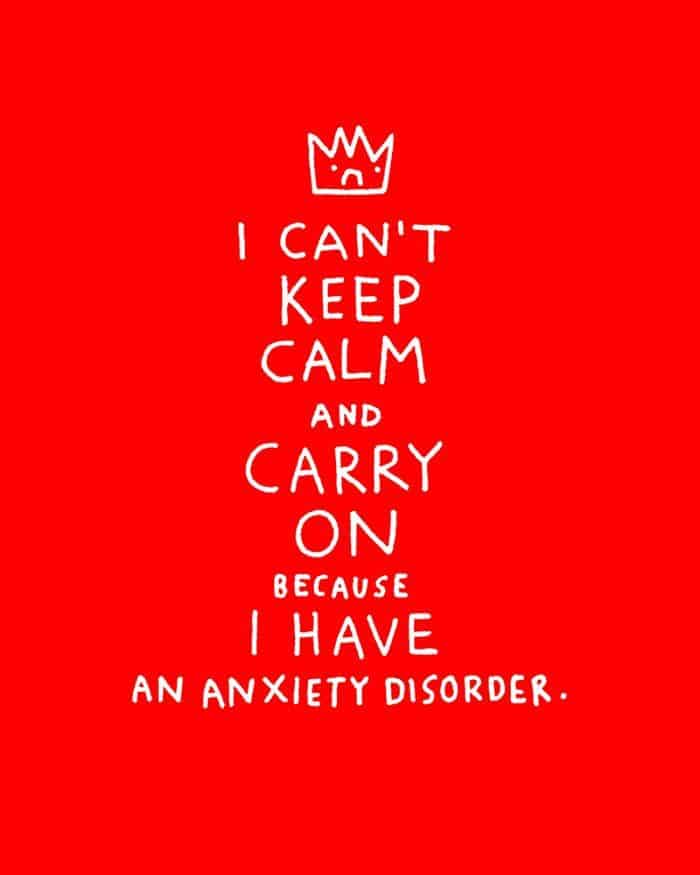All of us feel anxious now and again. It happens. Maybe you’re a bit on edge about work or stressed over a new problem that needs solving. Occasional anxiety is good because it has kept our species alive for over 200,000 years. An anxiety disorder, on the other hand, is potentially debilitating.
Millions of people around the world suffer from anxiety disorders. In the United States alone, it affects over 40 million people, and this number represents only those who’ve been diagnosed. The actual number is likely to be much higher. 100 million Americans or more could be affected.
So, why don’t most people with an anxiety disorder seek treatment? Some reasons include the unfortunate social stigma attached to mental health issues and the belief that their feelings aren’t unique. We’re intelligent enough to understand the human nature of anxiety and stress. However, many of us aren’t so smart about knowing when to admit a problem is present and doing something about it.
“Everyday Anxiety” and an “Anxiety Disorder”
The Anxiety and Depression Association of America (ADAA) distinguishes between normal, “everyday anxiety,” and an anxiety disorder. Here is a comparison chart:
| Everyday Anxiety | Anxiety Disorder |
| Worry about paying bills, landing a job, going through a romantic breakup, or other important life events. | Constant and unsubstantiated worry causes significant distress and interferes with daily life. |
| Embarrassment / self-consciousness while in an uncomfortable or awkward social situation. | Avoiding social situations because of a fear of being judged, embarrassed, or humiliated. |
| A case of nerves or sweating before a big test, business presentation, stage performance, or other significant event. | Seemingly out-of-the-blue panic attacks and preoccupation with / fear of having another one. |
| Realistic fear of a dangerous object, place, or situation. | Irrational fear or avoidance of an object, place, or situation. |
| Anxiety, sadness, or difficulty falling asleep immediately after a traumatic event. | Recurring nightmares, flashbacks, or emotional numbing related to a traumatic event occurred several months or years before. |
Let’s talk about a few more signs of a possible anxiety disorder. In the end, we’ll discuss techniques for managing anxiety!
Modern psychology recognizes these 11 signs of an anxiety disorder:

1. Excessive worry
Besides depression, generalized anxiety disorder (GAD) is the most prevalent mental health disorder. Strongly correlated with GAD, excessive worry manifests through “anxious thoughts on most days of the week.” If this continues for at least six months, GAD might be the reason.
2. Irrational fears
Also called a “phobia,” irrational fear can seriously affect the quality of one’s life. Common phobias include animals, crowds, flying, germs, noise, and skin contact. Phobias can be treated (and usually overcome) by a psychological technique called exposure therapy.
3. Chronic indigestion
Yep, anxiety disorders can wreak havoc on your tummy. Irritable Bowel Syndrome, or IBS, is sometimes referred to as “anxiety in the digestive tract” because of the condition’s association with anxiety and stress. IBS includes symptoms such as bloating, constipation, cramping, diarrhea, gas, and stomachaches.
4. Self-consciousness
Social anxiety disorder involves the fear and anxiety of being negatively evaluated and judged by others. People who suffer from the condition are often very self-conscious and feel as if all eyes are on them. As a result, they feel highly tense and uncomfortable in most social environments.
5. Perfectionism
To be labeled a perfectionist is not a compliment in the context of an anxiety disorder. In this case, it means someone constantly applies pressure on themself to be a hundred percent “on” at all times. This continuous stress is too much to bear, creating anxious feelings.
6. Self-doubt
Common among anxiety disorders, GAD, and obsessive-compulsive disorder (OCD), is persistent self-doubt and second-guessing. This self-doubt may revolve around identity crisis issues.
7. Compulsive behaviors
First thing’s first: if you haven’t seen the movie As Good as It Gets, put it on your to-do list. Jack Nicholson performs brilliantly as an irritable, stubborn, middle-aged man who suffers from OCD. Nicholson’s character speaks impulsively, interrupts constantly, and offends unapologetically.
He can’t help any of these behaviors; they are compulsory. OCD symptoms work the same way in real life (albeit less rudely).
8. Flashbacks
Post-traumatic stress disorder (PTSD) is often associated with war; however, numerous things can cause someone to develop this severe anxiety disorder. These events can include physical and sexual assault, bullying, emotional abuse, etc.
Flashbacks involve troubling and vivid mental “flashes” of the traumatic event. These are extremely common in individuals suffering from a trauma-related disorder.
9. Panic
As an extreme form of anxiety disorder, panic attacks manifest when a person suddenly feels intense fear and a sensation of impending doom. Some have described a panic attack as feeling like they were going to die. Note that shortness of breath, disorientation, trembling, and sweating are common panic attack symptoms.
10. Difficulty sleeping
Anxiety disorders reshape the brain into a more reactive organ. While in chronic form, anxiety wires the brain to be ultra-sensitive to stimulation of any kind. This neural rewiring can keep the brain on overdrive, even when the mind should be “quiet.” When your body needs sleep, anxiety interferes.
11. Muscle tension
Anxiety disorders are rooted in the brain’s limbic system, specifically the fight-or-flight response. Fight-or-flight heightens our senses should we need to flee from immediate danger. While this is an evolutionary response, this apparatus is often flipped to “on” in the anxious brain. Such neural activity causes the anxious person to “tense up.” Due to this anxiety, they may contract their head, face, shoulder, abdominal, pelvic, and leg muscles.

Final Thoughts: Help For Anxiety
Deepak Chopra, M.D., a board-certified physician and alternative health advocate, admonishes the pill-popping culture prevalent in traditional healthcare. Concerning anxiety, Dr. Chopra says, “… millions of sufferers pop a tranquilizer prescribed by the doctor … this quick fix (only) lessens symptoms without addressing what is causing the anxiety.”
Chopra continues, “Self-care is the best option for anyone who feels mild to moderate anxiety, whether a specific event caused it or not.”
On this note, some natural methods of caring for your anxiety include:
- Avoiding alcohol and tobacco.
- Addressing the issues causing stress in your life.
- Learning to be mindful or practicing meditation (or both!).
- Getting regular sleep (usually 8-9 hours every night).
- Accepting anxiety as it comes without judgment.
- Seeking out help, whatever that means to you if the condition becomes too much.

















